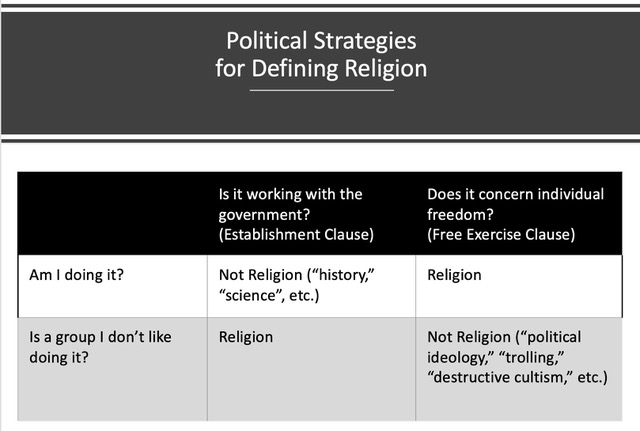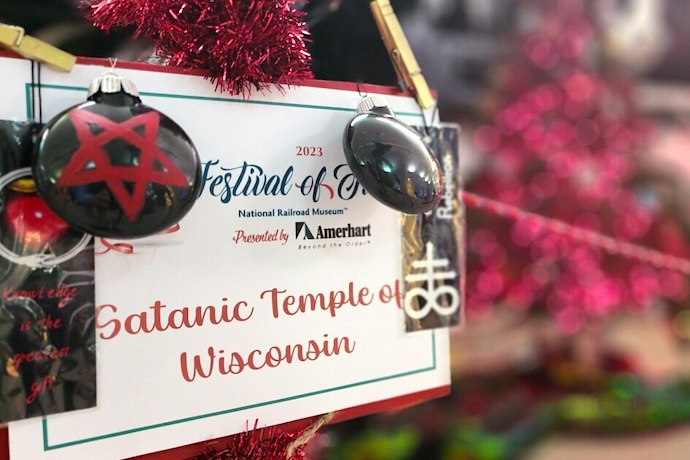Forget ugly sweater parties, this is our new national Christmas tradition: 1) a public venue creates a forum and invites everyone to erect displays; 2) Secular Humanists, Satanists, and other subversives participate; 3) moral entrepreneurs feign outrage that the public was allowed to express viewpoints at a public forum. We have repeated this exact War-on-Christmas pattern for nearly 10 years running.
It seems we’ve started early this year. On November 15, the National Railroad Museum in Ashwaubenon, Wisconsin, began its “Festival of Trees.” Sixty-six businesses and charitable organizations, including The Satanic Temple of Wisconsin, donated trees to the Museum, which is privately funded and accepts no tax dollars (save for occasional grants). The response was predictable as conservative Christian groups rushed to condemn the five-foot tree adorned with red Christmas lights, upside-down crosses, and messages like “Hail Santa.”
Bishop David L. Ricken of the Diocese of Green Bay released a statement claiming that the “traditional understanding of Christmas” was being “usurped and desecrated by an organization/cult.” Bill Donahue of The Catholic League called Museum CEO Jacqueline Frank a “disingenuous person” involved in an “anti-Christmas scam,” while the Religious Freedom Institute (RFI) hysterically called the tree “an attack on the religious freedom of all Americans.”
This year’s crop of outrage was a master class in the rhetorical gymnastics deployed in cases like this: Participating in a public forum is an attack; Christmas is a secular holiday to be celebrated in government offices, yet simultaneously so sacred that celebrating it “incorrectly” is an affront to Christianity; and “Religion” is a vague category deployed in inconsistent and self-serving ways. These contradictions were always there. What’s significant about groups like The Satanic Temple is that their provocations draw these contradictory claims to the surface.
The Satanic tree features an upside-down cross ornament, but it’s largely playful. Any harm caused by the displays at the “Festival of Trees” is subjective. For example, a tree covered in hardware and a Lego tree went unnoticed, while Bill Donohue took offense at an ornament on the “gender diversity” tree that merely stated “Be Weird.” These objections are examples of what classical liberal philosopher John Stuart Mill called “constructive injuries”—annoyances “which society can afford to bear, for the sake of the greater good of human freedom.” The language of “desecration,” “scams,” and “attacks” is meant to divert attention from the fact that a free society can afford to bear a Satanic tree. Deploying words normally reserved to describe violence and criminality is meant to reframe hurt feelings as objective harm.
Another talking point is that, since Christmas is a Christian holiday, Satanists participating in December festivities constitutes an attack on Christianity. Donohue concludes his essay, “There is no other way to interpret the TST anti-Christmas display at the Museum than to say that it is demonstrating hostility to Christianity.”
First, the “Festival of Trees” is expressly not a Christmas celebration. Museum CEO Jacqueline Frank, who specified that all religions are welcome, also noted that, of the 66 trees in the festival, only six are from Christian groups. Second, as the Satanists are quick to point out, the Christmas tree was a pagan symbol before it was a Christian one, so claims of desecrating the “traditional understanding of Christmas” are murky at best.
Third and most importantly, the Supreme Court declared in Lynch v. Donnelly (1983) that Christmas is not necessarily a Christian holiday! That case concerned whether a crèche displayed on government property in Pawtucket, Rhode Island, violated the establishment clause. The court ruled 5-4 that it did not, largely because the crèche was surrounded by other symbols that evoked Christmas but were not Christian, like Santa, reindeer, etc. As Sandra Day O’Connor explained in her concurrence, “The display celebrates a public holiday, and no one contends that declaration of that holiday is understood to be an endorsement of religion. The holiday itself has very strong secular components and traditions.”
That decision laid the foundation for more Christmas displays on government property, including Texas’s “Merry Christmas Bill,” which allows public schools to erect Christmas displays so long as there is “a scene or symbol of more than one religion” or “at least one secular scene or symbol.”
Note the heads I win/tails you lose logic here: Christmas can be either a religious holiday or a secular one and only the Supreme Court can decide this for certain. When a Christmas display on government property appears to violate the establishment clause, it’s a secular holiday. But when Satanists attempt to participate in a secular holiday display, it magically becomes a Christian holy day and their participation is an attack on Christians.
Even more slippery than claims about the nature of Christmas is the category of “religion.” RFI’s slogan is “Working to Secure Religious Freedom for Everyone, Everywhere.” But, in practice, they seem intent on challenging the freedom of minority religious groups like The Satanic Temple. They conceal this paradox by labeling religions they don’t like as “anti-religion forces.”
According to RFI: “To say The Satanic Temple, which rejects God and hates religion, is a religion is to render as nonsense one of the most important words in the English language and in American public life.” The Satanic Temple does not “hate religion,” but even if they did, this would not disqualify them from being a religion. Evangelicals sometimes claim they “hate religion, but love Jesus,” but you can bet the RFI wouldn’t therefore claim that evangelicals have no religious rights.

Slide from a presentation used by the author in religious studies classes.
So why isn’t The Satanic Temple a religion? The RFI doesn’t say. It’s implied they’re not a religion because they don’t believe in God. But in United States v. Seeger (1965), the Supreme Court ruled that belief in a Supreme Being is not required to be considered a religion (a decision that certainly didn’t render the word religion “nonsense”). Furthermore, in 2019 The Satanic Temple was recognized by the IRS as a church.
The RFI never defines the thing they claim to defend. Religion scholar Russell McCutcheon has argued that the ambiguity of the word “religion” is a feature, not a bug. As he puts it, “[religion’s] utility is linked to its inability to be defined.” Just as Christmas can be either religious or secular depending on whose interests are being served, a group can be either a religion or an “anti-religious force” as needed in order to create the impression of complying with the establishment clause while actually advancing Christian privilege.
Someone—not Einstein—once stated that the definition of insanity is doing the same thing over and over and expecting different results. As a society we can have good faith discussions about things like religious tolerance and public displays and achieve some sort of understanding, or we can continue to play word games and perpetuate the cycle of outrage. But perhaps the annual December hullabaloo, with its opportunities for political posturing and social media clout, is also a feature rather than a bug. Maybe all we actually want for the holidays is a sense of righteous outrage.





